tow RENAULT KOLEOS 2012 1.G Owners Manual
[x] Cancel search | Manufacturer: RENAULT, Model Year: 2012, Model line: KOLEOS, Model: RENAULT KOLEOS 2012 1.GPages: 233, PDF Size: 7.81 MB
Page 15 of 233
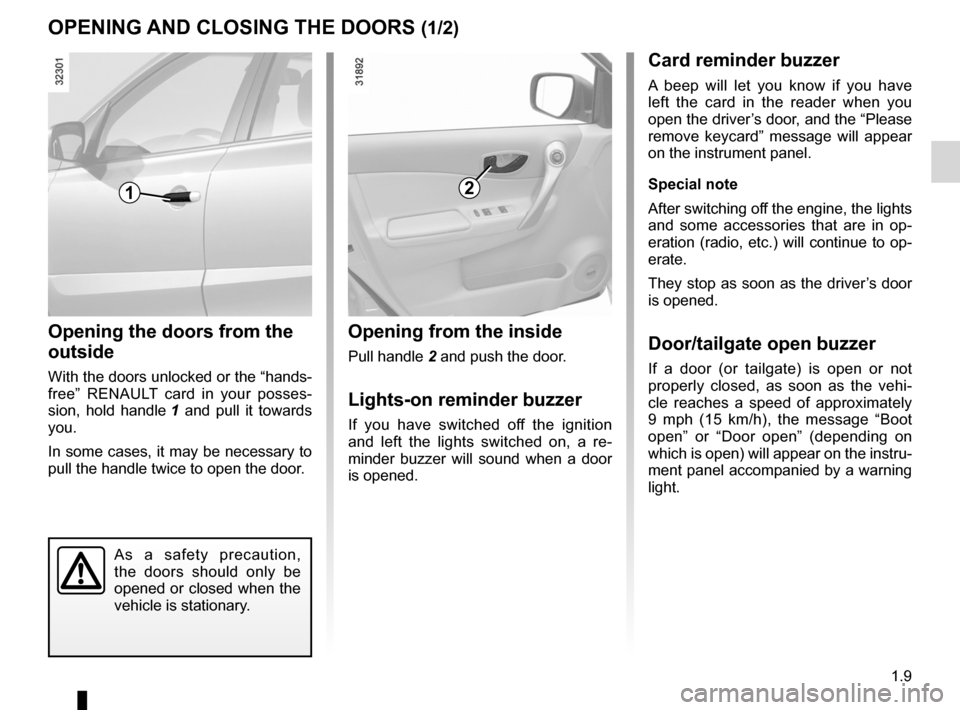
doors..................................................... (up to the end of the DU)
locking the doors .................................. (up to the end of the DU)
opening the doors ................................. (up to the end of the DU)
closing the doors .................................. (up to the end of the DU)
warning buzzer ...................................................... (current page)
1.9
ENG_UD27285_7
Ouverture et fermeture des portes (X45 - H45 - Renault)
ENG_NU_977-2_H45_Ph2_Renault_1
Doors
OpENINg ANd cLOsINg ThE dOORs (1/2)
2
Opening the doors from the
outside
With the doors unlocked or the “hands -
free” RENAULT card in your posses -
sion, hold handle 1 and pull it towards
you.
In some cases, it may be necessary to
pull the handle twice to open the door.
Opening from the inside
Pull handle 2 and push the door.
Lights-on reminder buzzer
If you have switched off the ignition
and left the lights switched on, a re -
minder buzzer will sound when a door
is opened.
card reminder buzzer
A beep will let you know if you have
left the card in the reader when you
open the driver’s door, and the “Please
remove keycard ” message will appear
on the instrument panel.
special note
After switching off the engine, the lights
and some accessories that are in op -
eration (radio, etc.) will continue to op-
erate.
They stop as soon as the driver’s door
is opened.
door/tailgate open buzzer
If a door (or tailgate) is open or not
properly closed, as soon as the vehi -
cle reaches a speed of approximately
9 mph (15 km/h), the message “ Boot
open ” or “ Door open ” (depending on
which is open) will appear on the instru-
ment panel accompanied by a warning
light.
1
As a safety precaution,
the doors should only be
opened or closed when the
vehicle is stationary.
Page 60 of 233
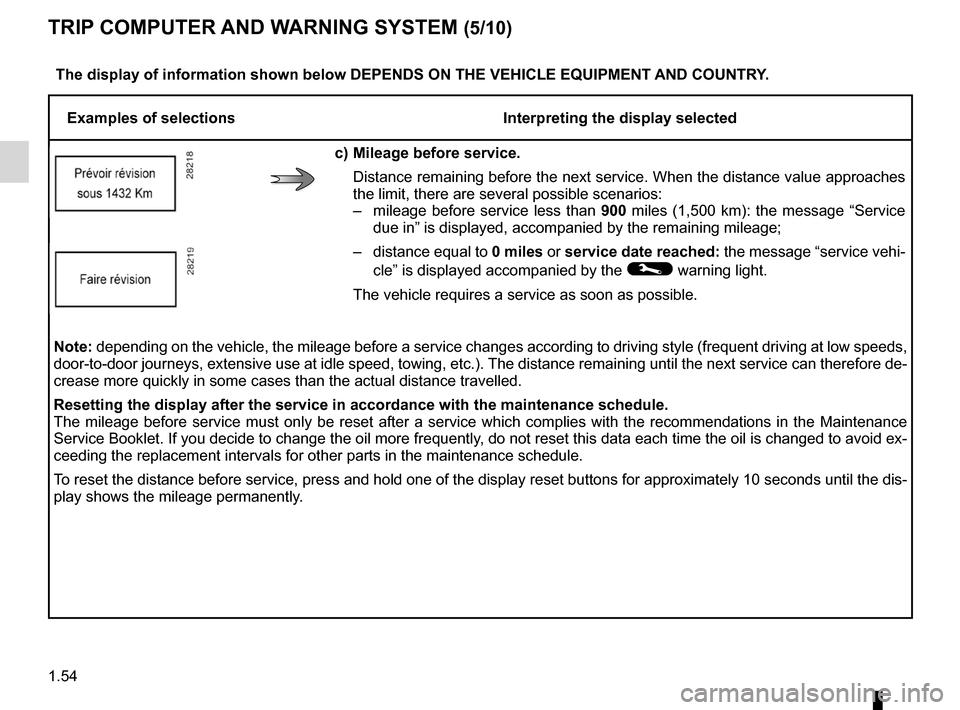
1.54
ENG_UD27277_8
Ordinateur de bord (X45 - H45 - Renault)
ENG_NU_977-2_H45_Ph2_Renault_1
Jaune NoirNoir texte
TRIp cOMpUTER ANd WARNINg sYsTEM (5/10)
The display of information shown below dEpENds ON ThE vEhIcLE EQUIpMENT ANd cOUNTRY.
Examples of selections Interpreting the display selected
c) Mileage before service.
Distance remaining before the next service. When the distance value approaches
the limit, there are several possible scenarios:
– mileage before service less than 900 miles (1,500 km): the message “Service
due in ” is displayed, accompanied by the remaining mileage;
– distance equal to 0 miles or service date reached: the message “service vehi-
cle” is displayed accompanied by the
© warning light.
The vehicle requires a service as soon as possible.
Note: depending on the vehicle, the mileage before a service changes according to driving style (frequent driving at low speeds,
door-to-door journeys, extensive use at idle speed, towing, etc.). The distance remaining until the next service can therefore de-
crease more quickly in some cases than the actual distance travelled.
Resetting the display after the service in accordance with the maintenance schedule.
The mileage before service must only be reset after a service which complies with the recommendations in the Maintenance
Service Booklet. If you decide to change the oil more frequently, do not reset this data each time the oil is changed to avoid ex-
ceeding the replacement intervals for other parts in the maintenance schedule.
To reset the distance before service, press and hold one of the display reset buttons for approximately 10 seconds until the dis-
play shows the mileage permanently.
Page 68 of 233
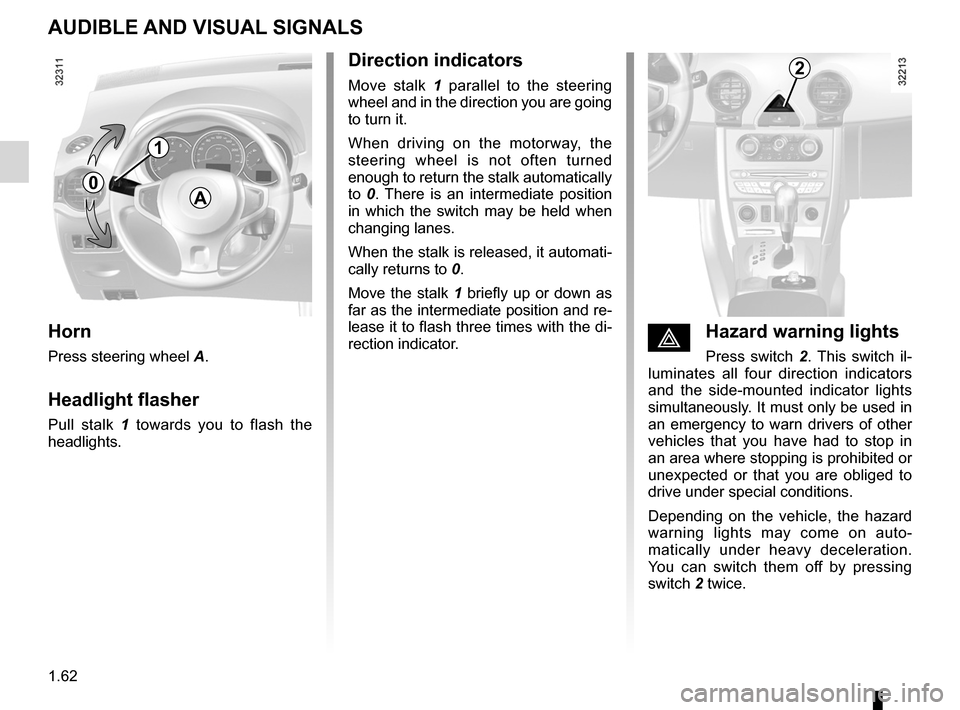
horn ...................................................... (up to the end of the DU)
warning buzzer ..................................... (up to the end of the DU)
headlight flashers ................................. (up to the end of the DU)
lights: hazard warning ............................... (up to the end of the DU)
lights: direction indicators .......................... (up to the end of the DU)
hazard warning lights signal ................. (up to the end of the DU)
hazard warning lights signal ................. (up to the end of the DU)
horn: flash ................................................ (up to the end of the DU)
horn: sounding the horn ........................... (up to the end of the DU)
horn ...................................................... (up to the end of the DU)
1.62
ENG_UD23299_3
Avertisseurs sonores et lumineux (X45 - H45 - Renault)
ENG_NU_977-2_H45_Ph2_Renault_1
Audible and visual signals
AUdIBLE ANd vIsUAL sIgNALs
horn
Press steering wheel A.
headlight flasher
Pull stalk 1 towards you to flash the
headlights.
direction indicators
Move stalk 1 parallel to the steering
wheel and in the direction you are going
to turn it.
When driving on the motorway, the
steering wheel is not often turned
enough to return the stalk automatically
to 0 . There is an intermediate position
in which the switch may be held when
changing lanes.
When the stalk is released, it automati-
cally returns to 0.
Move the stalk 1 briefly up or down as
far as the intermediate position and re-
lease it to flash three times with the di-
rection indicator.
éhazard warning lights
Press switch 2 . This switch il -
luminates all four direction indicators
and the side-mounted indicator lights
simultaneously. It must only be used in
an emergency to warn drivers of other
vehicles that you have had to stop in
an area where stopping is prohibited or
unexpected or that you are obliged to
drive under special conditions.
Depending on the vehicle, the hazard
warning lights may come on auto -
matically under heavy deceleration.
You can switch them off by pressing
switch 2 twice.
1
0A
2
Page 69 of 233
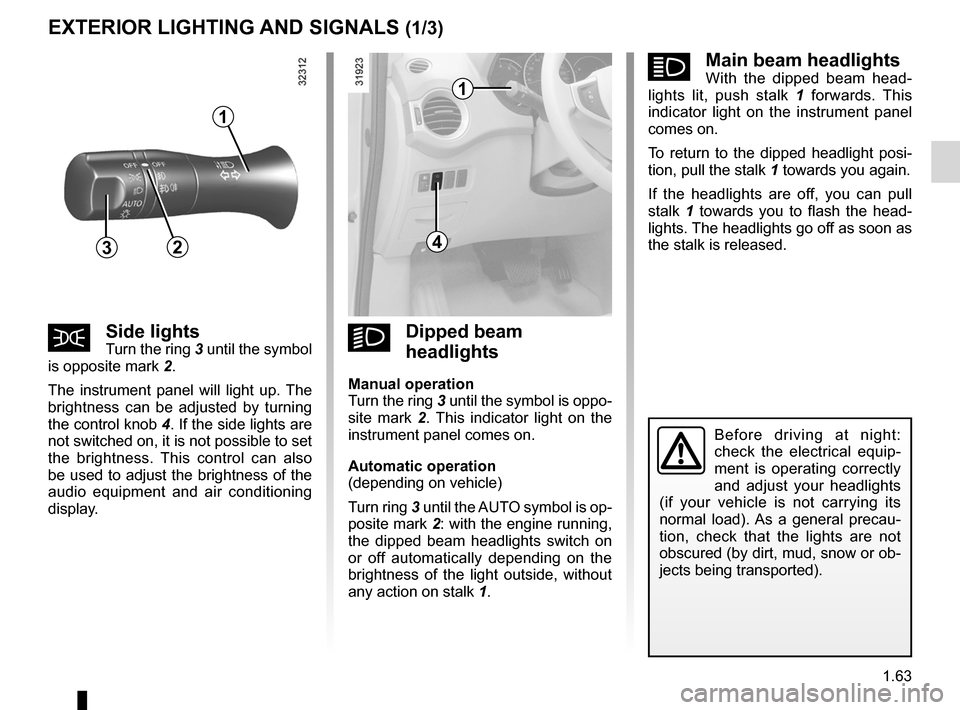
lighting:exterior ............................................ (up to the end of the DU)
instrument panel ................................... (up to the end of the DU)
lights: side lights ........................................ (up to the end of the DU)
lights: dipped beam headlights .................. (up to the end of the DU)
hazard warning lights signal ................. (up to the end of the DU)
signals and lights .................................. (up to the end of the DU)
lighting: instrument panel ............................. (up to the end of the DU)
1.63
ENG_UD23490_3
Eclairages et signalisations extérieures (X45 - H45 - Renault)
ENG_NU_977-2_H45_Ph2_Renault_1
Exterior lighting and signals
EXTERIOR LIghTINg ANd sIgNALs (1/3)
kdipped beam
headlights
Manual operation
Turn the ring 3 until the symbol is oppo -
site mark 2 . This indicator light on the
instrument panel comes on.
Automatic operation
(depending on vehicle)
Turn ring 3 until the AUTO symbol is op-
posite mark 2: with the engine running,
the dipped beam headlights switch on
or off automatically depending on the
brightness of the light outside, without
any action on stalk 1.
šside lightsTurn the ring 3 until the symbol
is opposite mark 2.
The instrument panel will light up. The
brightness can be adjusted by turning
the control knob 4. If the side lights are
not switched on, it is not possible to set
the brightness. This control can also
be used to adjust the brightness of the
audio equipment and air conditioning
display.
áMain beam headlightsWith the dipped beam head -
lights lit, push stalk 1 forwards. This
indicator light on the instrument panel
comes on.
To return to the dipped headlight posi-
tion, pull the stalk 1 towards you again.
If the headlights are off, you can pull
stalk 1 towards you to flash the head -
lights. The headlights go off as soon as
the stalk is released.
Before driving at night:
check the electrical equip -
ment is operating correctly
and adjust your headlights
(if your vehicle is not carrying its
normal load). As a general precau -
tion, check that the lights are not
obscured (by dirt, mud, snow or ob-
jects being transported).
1
432
1
Page 70 of 233
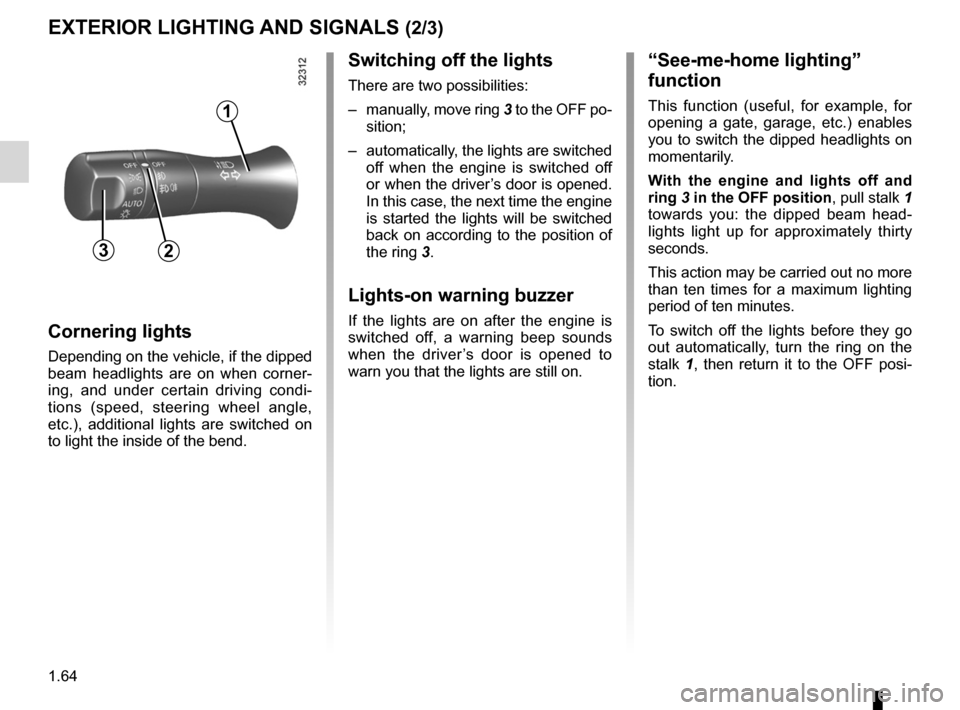
lightsmobile directional ............................................. (current page)
see-me-home lighting ............................................ (current page)
lights-on warning buzzer ........................................ (current page)
1.64
ENG_UD23490_3
Eclairages et signalisations extérieures (X45 - H45 - Renault)
ENG_NU_977-2_H45_Ph2_Renault_1
Jaune NoirNoir texte
EXTERIOR LIghTINg ANd sIgNALs (2/3)
cornering lights
Depending on the vehicle, if the dipped
beam headlights are on when corner -
ing, and under certain driving condi -
tions (speed, steering wheel angle,
etc.), additional lights are switched on
to light the inside of the bend.
switching off the lights
There are two possibilities:
– manually, move ring 3 to the OFF po-
sition;
– automatically, the lights are switched
off when the engine is switched off
or when the driver’s door is opened.
In this case, the next time the engine
is started the lights will be switched
back on according to the position of
the ring 3.
Lights-on warning buzzer
If the lights are on after the engine is
switched off, a warning beep sounds
when the driver ’s door is opened to
warn you that the lights are still on.
“see-me-home lighting”
function
This function (useful, for example, for
opening a gate, garage, etc.) enables
you to switch the dipped headlights on
momentarily.
With the engine and lights off and
ring 3 in the Off position , pull stalk 1
towards you: the dipped beam head -
lights light up for approximately thirty
seconds.
This action may be carried out no more
than ten times for a maximum lighting
period of ten minutes.
To switch off the lights before they go
out automatically, turn the ring on the
stalk 1 , then return it to the OFF posi -
tion.
32
1
Page 80 of 233
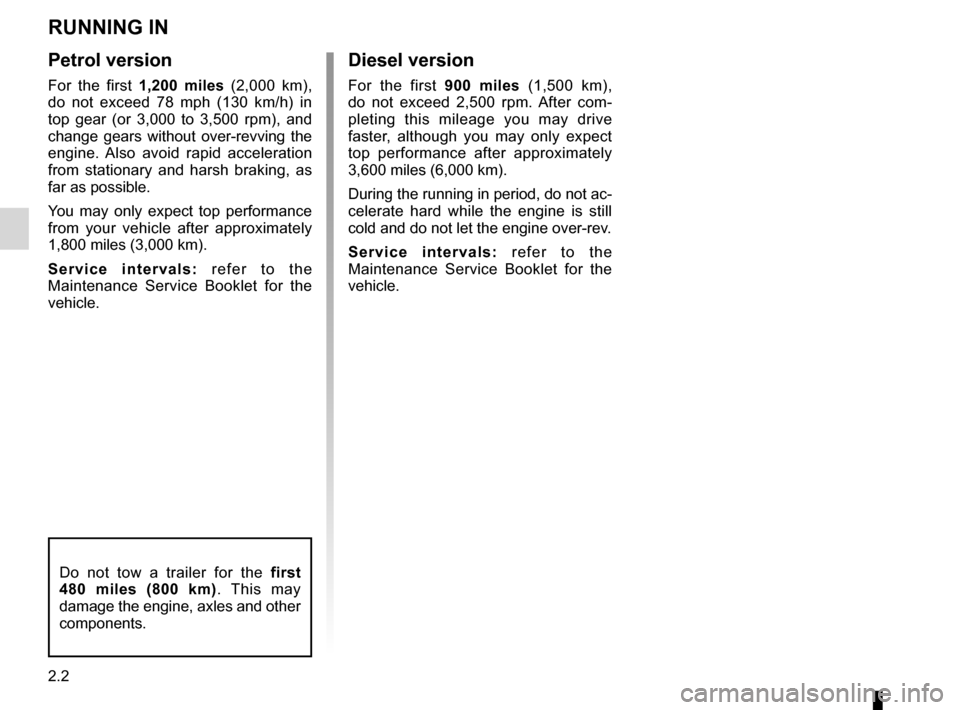
running in .............................................. (up to the end of the DU)
driving ................................................... (up to the end of the DU)
2.2
ENG_UD20969_3
Rodage (X45 - H45 - Renault)
ENG_NU_977-2_H45_Ph2_Renault_2
Running in
RUNNING IN
Petrol version
For the first 1,200 miles (2,000 km),
do not exceed 78 mph (130 km/h) in
top gear (or 3,000 to 3,500 rpm), and
change gears without over-revving the
engine. Also avoid rapid acceleration
from stationary and harsh braking, as
far as possible.
You may only expect top performance
from your vehicle after approximately
1,800 miles (3,000 km).
S e r v i c e i n t e r v a l s : r e f e r t o t h e
Maintenance Service Booklet for the
vehicle.
Diesel version
For the first 900 miles (1,500 km),
do not exceed 2,500 rpm. After com -
pleting this mileage you may drive
faster, although you may only expect
top performance after approximately
3,600 miles (6,000 km).
During the running in period, do not ac-
celerate hard while the engine is still
cold and do not let the engine over-rev.
S e r v i c e i n t e r v a l s : r e f e r t o t h e
Maintenance Service Booklet for the
vehicle.
Do not tow a trailer for the first
480 miles (800 km) . This may
damage the engine, axles and other
components.
Page 84 of 233
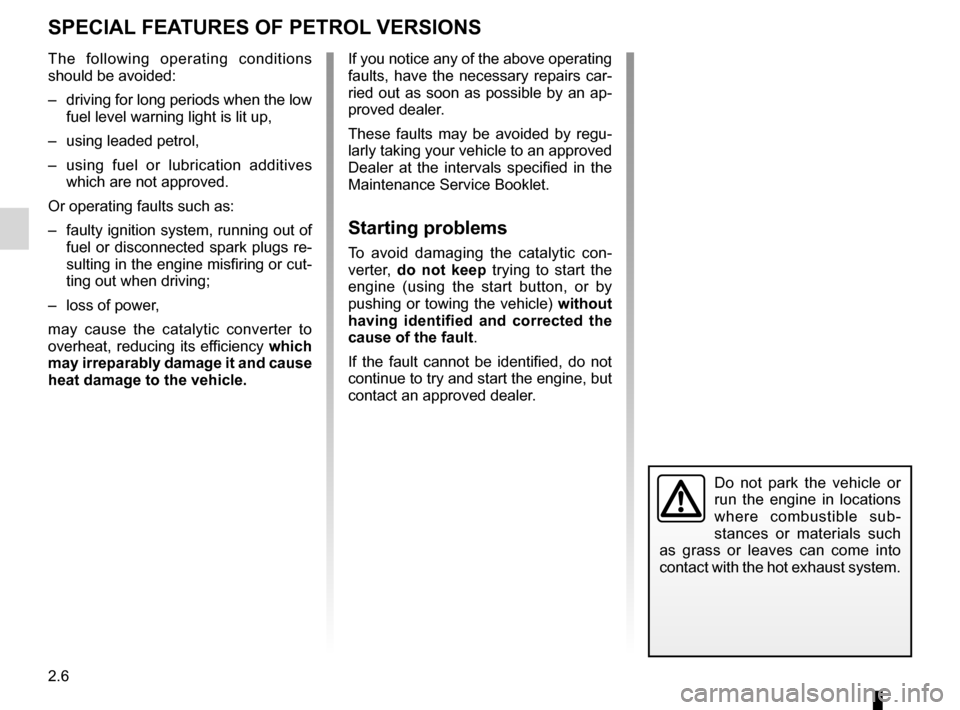
special features of petrol vehicles ........ (up to the end of the DU)
driving ................................................... (up to the end of the DU)
catalytic converter ................................. (up to the end of the DU)
2.6
ENG_UD20970_4
Particularit s des versions essence (X45 - H45 - X81 - X95 - B95 - D95 - Renault)
ENG_NU_977-2_H45_Ph2_Renault_2
Special features of petrol versions
SPECIAL FEATURES OF PETROL vERSIONS
Do not park the vehicle or
run the engine in locations
where combustible sub -
stances or materials such
as grass or leaves can come into
contact with the hot exhaust system.
The following operating conditions
should be avoided:
– driving for long periods when the low
fuel level warning light is lit up,
– using leaded petrol,
– using fuel or lubrication additives
which are not approved.
Or operating faults such as:
– faulty ignition system, running out of
fuel or disconnected spark plugs re-
sulting in the engine misfiring or cut-
ting out when driving;
– loss of power,
may cause the catalytic converter to
overheat, reducing its efficiency which
may irreparably damage it and cause
heat damage to the vehicle. If you notice any of the above operating
faults, have the necessary repairs car-
ried out as soon as possible by an ap-
proved dealer.
These faults may be avoided by regu
-
larly taking your vehicle to an approved
Dealer at the intervals specified in the
Maintenance Service Booklet.
Starting problems
To avoid damaging the catalytic con -
verter, do not keep trying to start the
engine (using the start button, or by
pushing or towing the vehicle) without
having identified and corrected the
cause of the fault.
If the fault cannot be identified, do not
continue to try and start the engine, but
contact an approved dealer.
Page 89 of 233
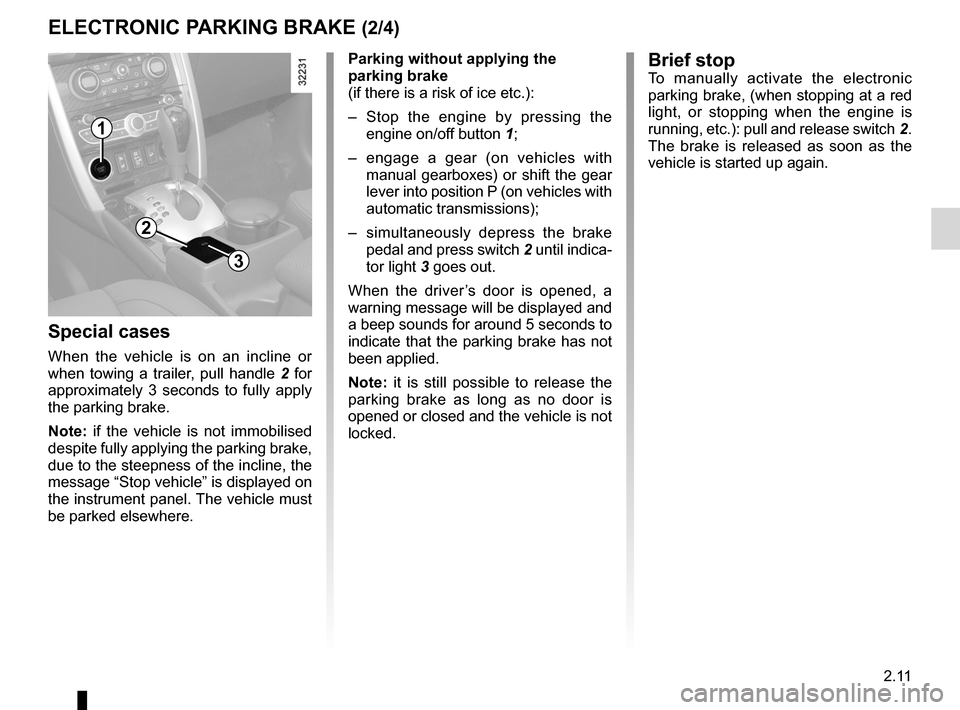
JauneNoirNoir texte
2.11
ENG_UD27280_8
Frein de parking assist (X45 - H45 - Renault)
ENG_NU_977-2_H45_Ph2_Renault_2
ELECTRONIC PARKING BRAKE (2/4)
Special cases
When the vehicle is on an incline or
when towing a trailer, pull handle 2 for
approximately 3 seconds to fully apply
the parking brake.
Note: if the vehicle is not immobilised
despite fully applying the parking brake,
due to the steepness of the incline, the
message “Stop vehicle ” is displayed on
the instrument panel. The vehicle must
be parked elsewhere. Parking without applying the
parking brake
(if there is a risk of ice etc.):
–
Stop the engine by pressing the
engine on/off button 1;
– engage a gear (on vehicles with
manual gearboxes) or shift the gear
lever into position P (on vehicles with
automatic transmissions);
– simultaneously depress the brake
pedal and press switch 2 until indica-
tor light 3 goes out.
When the driver ’s door is opened, a
warning message will be displayed and
a beep sounds for around 5 seconds to
indicate that the parking brake has not
been applied.
Note: it is still possible to release the
parking brake as long as no door is
opened or closed and the vehicle is not
locked.
1
2
3
Brief stopTo manually activate the electronic
parking brake, (when stopping at a red
light, or stopping when the engine is
running, etc.): pull and release switch 2.
The brake is released as soon as the
vehicle is started up again.
Page 94 of 233
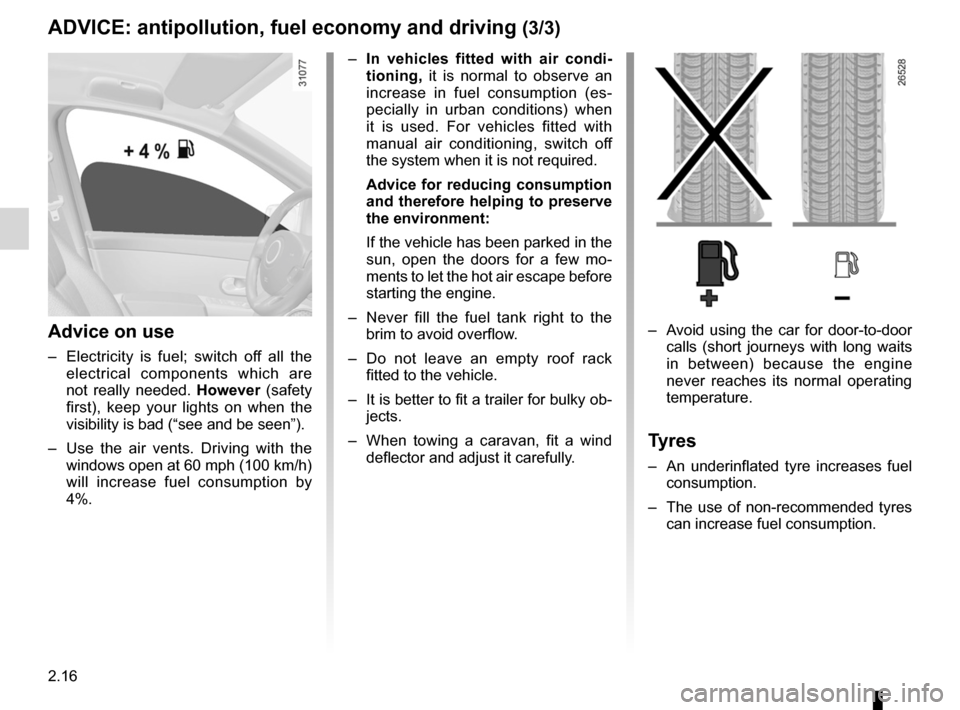
2.16
ENG_UD27288_2
Conseils : antipollution, conomies de carburant, conduite (X45 - H45 - Renault)
ENG_NU_977-2_H45_Ph2_Renault_2
ADvICE: antipollution, fuel economy and driving (3/3)
Advice on use
– Electricity is fuel; switch off all the
electrical components which are
not really needed. However (safety
first), keep your lights on when the
visibility is bad (“see and be seen”).
– Use the air vents. Driving with the
windows open at 60 mph (100 km/h)
will increase fuel consumption by
4%.
– Avoid using the car for door-to-door
calls (short journeys with long waits
in between) because the engine
never reaches its normal operating
temperature.
Tyres
– An underinflated tyre increases fuel
consumption.
– The use of non-recommended tyres
can increase fuel consumption.
–
In vehicles fitted with air condi -
tioning, it is normal to observe an
increase in fuel consumption (es -
pecially in urban conditions) when
it is used. For vehicles fitted with
manual air conditioning, switch off
the system when it is not required.
Advice for reducing consumption
and therefore helping to preserve
the environment:
If the vehicle has been parked in the
sun, open the doors for a few mo -
ments to let the hot air escape before
starting the engine.
– Never fill the fuel tank right to the
brim to avoid overflow.
– Do not leave an empty roof rack
fitted to the vehicle.
– It is better to fit a trailer for bulky ob-
jects.
– When towing a caravan, fit a wind
deflector and adjust it carefully.
Page 95 of 233
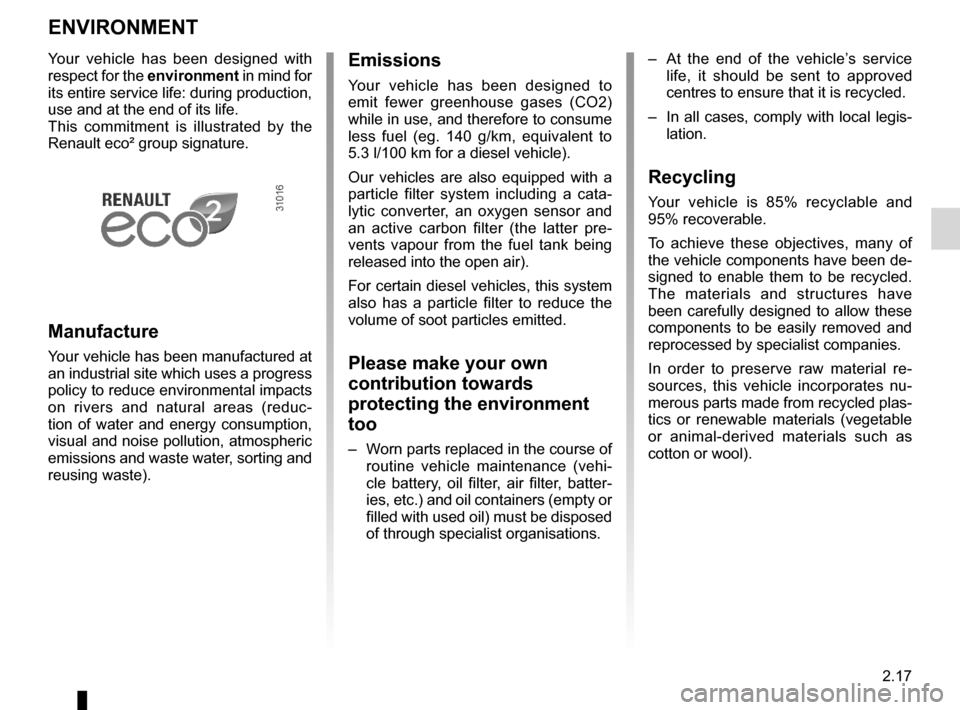
environment .......................................... (up to the end of the DU)
2.17
ENG_UD20974_4
Environnement (X35 - X44 - X45 - H45 - X65 - S65 - X77 - X81 - X85 - X91 - D91 - X76 - X83 - X61 - B65 - C65 - X77 ph2 - X95 - E95 - J95 - R95 - L38 - E33 - X33 - X38
ENG_NU_977-2_H45_Ph2_Renault_2
Environment
ENvIRONMENT
Emissions
Your vehicle has been designed to
emit fewer greenhouse gases (CO2)
while in use, and therefore to consume
less fuel (eg. 140 g/km, equivalent to
5.3 l/100 km for a diesel vehicle).
Our vehicles are also equipped with a
particle filter system including a cata -
lytic converter, an oxygen sensor and
an active carbon filter (the latter pre -
vents vapour from the fuel tank being
released into the open air).
For certain diesel vehicles, this system
also has a particle filter to reduce the
volume of soot particles emitted.
Please make your own
contribution towards
protecting the environment
too
– Worn parts replaced in the course of
routine vehicle maintenance (vehi -
cle battery, oil filter, air filter, batter -
ies, etc.) and oil containers (empty or
filled with used oil) must be disposed
of through specialist organisations. –
At the end of the vehicle’s service
life, it should be sent to approved
centres to ensure that it is recycled.
– In all cases, comply with local legis -
lation.
Recycling
Your vehicle is 85% recyclable and
95% recoverable.
To achieve these objectives, many of
the vehicle components have been de-
signed to enable them to be recycled.
The materials and structures have
been carefully designed to allow these
components to be easily removed and
reprocessed by specialist companies.
In order to preserve raw material re -
sources, this vehicle incorporates nu -
merous parts made from recycled plas-
tics or renewable materials (vegetable
or animal-derived materials such as
cotton or wool).
Your vehicle has been designed with
respect for the
environment in mind for
its entire service life: during production,
use and at the end of its life.
This commitment is illustrated by the
Renault eco² group signature.
Manufacture
Your vehicle has been manufactured at
an industrial site which uses a progress
policy to reduce environmental impacts
on rivers and natural areas (reduc -
tion of water and energy consumption,
visual and noise pollution, atmospheric
emissions and waste water, sorting and
reusing waste).